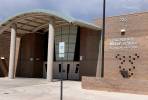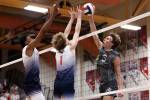Nevada trails most states on national student vocabulary test
Vocabulary isn't a strong suit for Nevada students, whose average scores on a redesigned test beat only a handful of other states, according to the Nation's Report Card released this week by the U.S. Department of Education.
Nevada fourth-graders scored higher than their peers in six other states on the vocabulary section of the 2011 National Assessment of Educational Progress reading assessment. The only lower average scores came from Alaska, California, Hawaii, Louisiana, Mississippi and New Mexico.
Nevada eighth-graders surpassed their peers in five other states: California, Hawaii, Louisiana, Mississippi and New Mexico.
Nationwide, a sample of 220,000 students was tested. The number of Nevada students who took part was not released.
Although Nevada's average scores ranked in the bottom 15 percent among the other states, Nevada did improve, which wasn't reflected nationwide, according to the report. Fourth-grade Nevada scores increased from 208 to 210 out of a possible 500. The cut score for the state's eighth-graders increased from 254 to 257.
"That's progress in the right direction," said Clark County School District spokeswoman Amanda Fulkerson, noting that the state also had improved in math and other areas of the national reading test under the Nation's Report Card in 2011.
Those improvements were also small and didn't lift the state above the national average.
"We know there's a long way to go and are dedicated to increasing academic achievement here in Clark County," Fulkerson said.
The implications of Nevada's poor vocabulary scores extend beyond simply being able to define challenging words, according to findings of the National Assessment Governing Body, which compared students' vocabulary scores with their scores in other areas.
Starting in 2009, the test departed from the tradition - which parents may remember from school - of asking students to pick the correct definition of an isolated word, such as "permeated." Instead, students were given a short passage using a word common in written language but not in everyday speech. They were asked for the meaning of the word as used.
In one example for eighth-graders, a question opened by stating mint syrup permeated the shaved ice. This means that the mint syrup:
A. Caused the shaved ice to melt slightly.
B. Formed the shaved ice into clumps.
C. Spread all the way through the shaved ice.
D. Made the shaved ice taste better.
Nationally, about 51 percent of students gave the correct answer of C, placing the word in the group of moderately understood words - including concocted, solace and tolerate - whose meanings were recognized by half to three-quarters of eighth-graders. But more than three-quarters of students grasped words such as "edible, icons and replicate."
Example words in the fourth-grade test included "spread and underestimate," which most students understood. "Barren and flourish" are examples of words that garnered correct student responses less than half the time.
David Driscoll, chairman of the governing board that sets policy for the assessment, said the reason for changing the test is that words are not used in isolation but in context.
"Helping students improve their vocabulary and use words in the proper context is essential to improving overall reading ability - essentially for students who most need to improve," Driscoll said.
He noted a "consistent relationship" between vocabulary scores and reading comprehension scores. Students scoring in the top quarter among their peers for reading comprehension also had the highest vocabulary scores. The same correlation persisted for the bottom scorers, he said.
Average scores of white and Asian students surpassed those of blacks and Hispanics nationwide by 20 to 30 points. And the gap isn't closing, especially not in Nevada.
The gap between student scores of white Nevadans and Hispanics widened by 4 points from 2009 to 2011 among fourth-graders. In 2009, the average score for Hispanic students was 196, trailing the 219 scored by white students. In 2011, the average score among Hispanics was 197 compared with 224 for white students. It widened by 4 points among eighth-graders for the same groups, with Hispanic scores increasing from 241 to 242 while white student scores moved from 267 to 272.
The gap between scores for white and black students widened by 2 points from 2009 to 2011 among fourth-graders. In 2009, blacks averaged a score of 198 while whites averaged 219. In 2011, black students scored 201 compared with whites who scored 224.
But black eighth-graders were able to close the gap with their white peers by 4 points. Black students scored 241 compared with white students who scored 267 in 2009. In 2011, that improved to an average score of 250 for black students and 272 for white students.
"Persistent achievement gaps ... need to be a focus of improvement," Driscoll said.
Contact reporter Trevon Milliard at tmilliard@reviewjournal.com or 702-383-0279.























